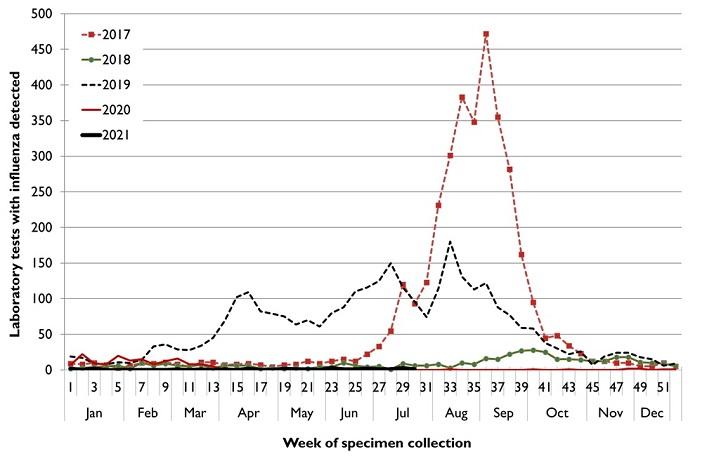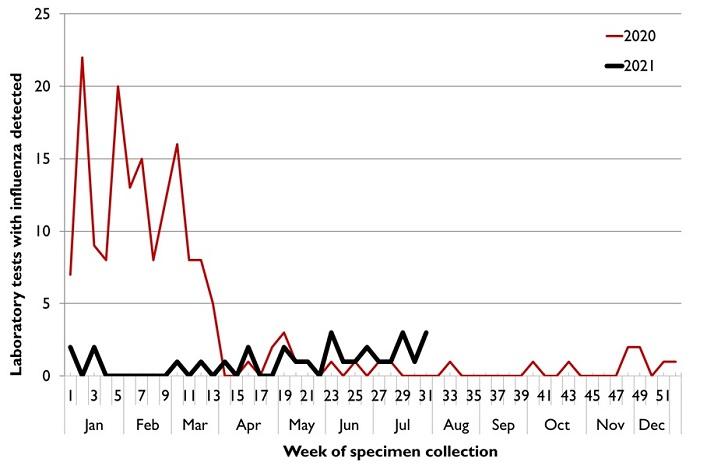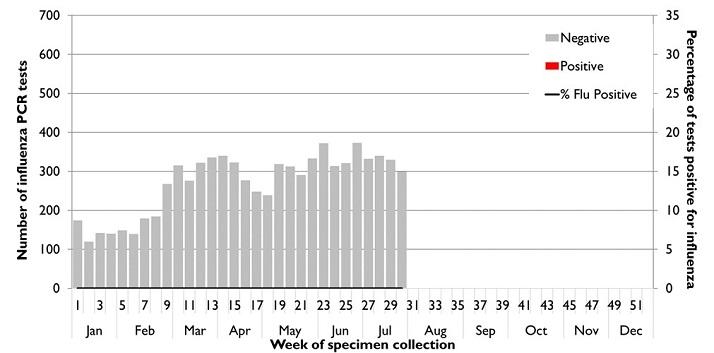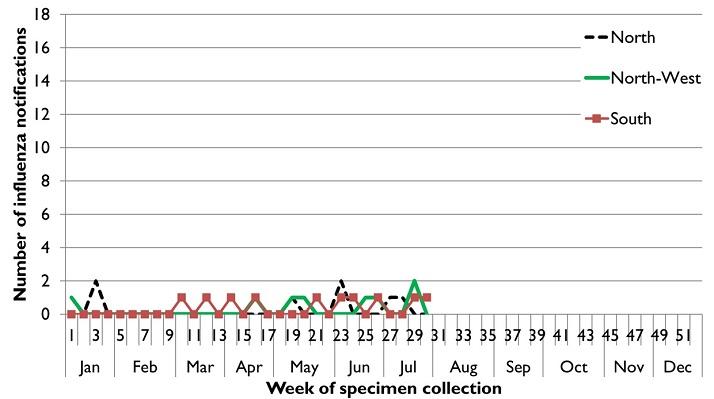fluTAS 2021 Report 3
Public Health Services produce the fluTAS Report to provide information about the level of influenza (flu) in Tasmania. Several influenza surveillance systems are used to provide an estimate of influenza activity in the community. This report describes influenza activity in Tasmania from 1 January 2021 to 1 August 2021 (week 30).
Data considerations
Interpretation of both 2020 and 2021 influenza activity data should take into account the influence of the COVID-19 epidemic in Australia. Results should be interpreted with caution, especially where comparisons are made to previous influenza seasons. Both 2020 and 2021 influenza activity data have likely been influenced by the impact of COVID-19 social distancing measures, changes in health seeking behaviour of the community, and focussed testing for COVID-19. Current COVID-19 related public health measures and the community’s adherence to public health messages are also likely having an effect on transmission of acute respiratory infections, including influenza.
2021 summary: 1 January to 1 August
- In 2021, the number of notifications of laboratory-confirmed influenza reported to Public Health Services in Tasmania continues to be low, following the significant reduction in influenza notifications observed from March 2020 onward.
- There have been 26 laboratory-confirmed influenza notifications in Tasmania to 1 August 2021. All of these notifications have all been detected by serology.
- A low level of influenza notifications continues to be observed nationally.
- 8,114 polymerase chain reaction (PCR) tests for influenza have been conducted in Tasmania to date with no PCR tests being positive for influenza.
Notifications of laboratory-confirmed influenza to Public Health Services
Influenza notifications are based on positive laboratory tests. Many people with influenza-like illness choose not to attend medical care or are not tested when they attend. Notifications therefore represent a small proportion of the total influenza cases in the community. Laboratory-confirmed influenza notifications are reported to Public Health Services in Tasmania from sentinel laboratories and then notified to the Australian Government Department of Health via the National Notifiable Diseases Surveillance System (NNDSS).
From 1 January 2021 to 1 August 2021 (week 30), Public Health Services received 26 laboratory confirmed notifications of influenza. All notifications were detected by serology. These comprised 14 cases of influenza A and 12 cases of influenza B. Notifications are 74 per cent lower than the 4-year (2016-2019) average of 100 notifications received over the same calendar period. Figure 1 shows the number of laboratory tests with influenza detected from 1 January 2017 to 1 August 2021. Figure 2 show the number of laboratory tests with influenza detected for the past two years from 1 January 2020 to 1 August 2021.
The number of notifications of laboratory-confirmed influenza reported to Public Health Services in Tasmania in 2021 continues to be low. This follows the significant reduction in influenza notifications observed from March 2020 onward. This decline coincided with the social distancing policies, implemented by the Commonwealth and Tasmanian Governments during March 2020 in response to the COVID-19 pandemic. A similar decline and ongoing pattern of low influenza notifications continues to be observed nationally.


Influenza testing
The polymerase chain reaction (PCR) assay is a rapid and sensitive method for detecting the genetic material of influenza viruses. In Tasmania, the weekly number of polymerase chain reaction (PCR) tests performed to detect influenza are reported to Public Health Services by two pathology providers, Royal Hobart Hospital (RHH) Pathology Services and Diagnostic Services Pty Ltd. As shown in Figure 2, 8,114 polymerase chain reaction (PCR) tests have been conducted to 1 August this year. There have been no PCR tests positive for influenza in Tasmania since 29 March 2020.

Other circulating respiratory illness
Many viruses cause the ‘common cold’ and ‘influenza-like illnesses’. RHH Pathology Services performs a PCR test that detects influenza A and influenza B viruses, as well as seven other respiratory pathogens commonly associated with respiratory illness.
RHH Pathology Services performed 4,812 PCR tests between 1 January and 1 August 2021. The most commonly detected respiratory viruses so far this year have been rhinovirus (51 percent), respiratory syncytial virus (27 percent), parainfluenza (16 percent) and adenovirus (6 percent).
Geographical distribution of activity
Of the 26 notified cases of influenza in Tasmania so far this year, 10 cases (38 percent) were from the South, 8 cases (31 percent) from the North and 8 cases (31 percent) from the North West.

Influenza-like illness
FluTracking (Community Syndromic Surveillance)
FluTracking is a national, weekly online survey that asks participants to report whether they have had fever and/or cough in the preceding week. It is a joint initiative of the University of Newcastle, Hunter New England Population Health and the Hunter Medical Research Institute. FluTracking information is available on the flutracking website and on Facebook
Annual Influenza Vaccine
Composition of 2021 influenza vaccines
The annual influenza vaccine is reviewed late each year, aiming to produce vaccines for the following year that provide protection from influenza strains likely to be common during winter. Advice on the formulation of annual influenza vaccines is provided to the Therapeutic Goods Administration (TGA) by the Australian Influenza Vaccine Committee (AIVC).
The AIVC recommendation for the composition of influenza vaccines for Australia in 2021 differs from last year's southern hemisphere recommendation with the inclusion of two new strains for the A (H1N1)-like and A (H3N2)-like viruses. The recommended virus for H3N2 has been previously included in the northern hemisphere vaccine.
Further information on the composition of 2021 influenza vaccines is available on the TGA website.
Is vaccination recommended?
Annual influenza vaccination is the most important measure to prevent influenza and its complications and is recommended for all people aged 6 months and older. Annual vaccination can help to reduce the spread of influenza and protect vulnerable members of the community.
Flu vaccines are available from GP’s and some pharmacies. Vaccines provided by pharmacies must be privately purchased. The following people may be eligible to get a funded flu vaccine from a GP;
- Children aged from six months to less than five years
- Everyone aged 65 years and over
- Pregnant women at any stage in their pregnancy.
- Aboriginal and Torres Strait Islander people over 6 months of age
- People over 6 months of age with certain medical conditions
Figure 1
Figure 1 is a line graph with a horizontal axis indicating the 52 weeks of the year. The vertical axis indicates the number of laboratory confirmed flu cases notified in Tasmania for each week of the year. Lines for the two years 2017 and 2018 each indicate low baseline flu activity between January and May as well as between November to December. The line for each year indicates that the peak of the flu season usually occurs between July and October. The line for 2017 indicates a year of high flu activity in Tasmania with a weekly peak above 450 flu cases occurring during August and September 2017. The line for 2018 indicates a year of very low flu activity with a peak of approximately 25 flu cases during early October 2018. The line for 2019 indicates that weekly flu cases were well above baseline levels between the middle of February and the middle of July. Activity was high early in the year with a high of 109 cases mid-April. Activity then decreased and increased steadily from 1 June to mid-July before decreasing again until the start of August. Weekly flu cases peaked again with a high of 180 cases during the middle of August before decreasing to the end of the year. The line indicating flu cases in Tasmania for 2020 shows relatively high notifications at the beginning of the year compared to previous years before decreasing in mid-March and remaining low. The line for 2021 indicates ongoing low flu activity.
Figure 2
Figure 2 is a line graph with a horizontal axis indicating the 52 weeks of the year. The vertical axis indicates the number of laboratory confirmed flu cases notified in Tasmania for each week of the year. The line indicating flu cases in Tasmania for 2020 shows relatively high notifications at the beginning of the year compared to previous years before decreasing in mid-March and remaining low. The line for 2021 indicates ongoing low flu activity from the beginning of the calendar year.
Figure 3
Figure 3 is a combined line and vertical bar graph. The horizontal axis indicates the months and weeks of 2020 moving left to right. The vertical axis on the left-hand side is the number of influenza polymerase chain reaction or PCR tests conducted per week (represented by bars in the figure). Each bar is split into two colours: positive tests are at the bottom of the bar, with negative tests stacked on top of the bar. The vertical axis on the right-hand side is the percentage of PCR tests that are positive for influenza (represented by a line overlaid on top of the bar graph in the figure). Data are currently presented for the first 30 weeks of 2021; 1 January to 1 August. The bar graph indicates an increase in testing in Tasmania during February and March. Influenza testing peaked in June with 373 tests conducted in week 26. There have been no PCR tests positive for influenza in Tasmania in 2021.
Figure 4
Figure 4 is a line graph with a horizontal axis indicating the 52 weeks of the year. The vertical axis indicates the number of laboratory confirmed flu cases notified in each region of Tasmania for each week of the year. Lines for each of the three regions, North, North-West and South, show that ten cases were reported in the South, eight cases were reported in the North and eight cases were reported in the North-West.
Document accessibility
We aim to provide documents in an accessible format. If you are having problems using a document with your accessibility tools, please contact us for help.
